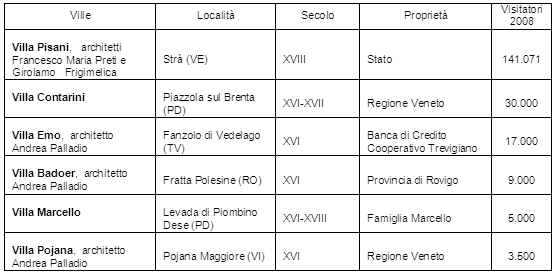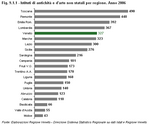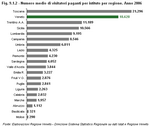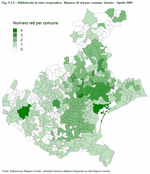9.1 Mobility of cultural heritage
|
In Europe the cultural sector is becoming increasingly recognised as a determining factor in the process of integration. Since its origins, the European Union has mainly been associated with economic and commercial goals, but in recent years it has taken on a wider dimension, opening out into the cultural sphere.
The EU's stance on culture is different to the individual national policies of its Member States as it aims to promote and bring together the various cultural identities with all their typical characteristics as resources to protect. Culture is important in all advanced economies and it is also associated with an increase in income. In Italy culture has particular relevance both because of the country's historical, artistic and cultural heritage-Italy has 40 of UNESCO's World Heritage Sites-and because citizens are devoting increasing time to culture. Education, well-being and freetime have increased along with the demand for culture and entertainment. As a result, the offer has increased accordingly. Citizens have increased their consumption of culture, both in traditional forms-visual arts, music, and live shows-and especially in the spread of products of cultural industries and the media, including new media through Information and Communication Technologies (ICT). It is therefore important to draw attention to the "march towards change" of some particularly significant cultural sectors in Veneto.
Since the 1980s there has been a rise in cultural tourism, which has highlighted the sector's economic value. In particular the role of museums has been promoted, placing them at the forefront of an economy driven by tourism based on culture. Unfortunately it would seem that over recent months even this sphere has suffered from the current economic crisis.
There is a particularly wide range of cultural sites in the region. In 2006 there were 327 non-state museums in the region, as well as about 100 other museums that have not been taken into account here as they were newly opened, closed for restoration, not open continuously, or are small in terms of size or content. To these can be added a further 14 state-owned museums, groups of affiliated museums, and archaeological sites. In Italy there are about 4,526 museums and art galleries that are not directly run by the state. Veneto hosts about 7.2% of these. Even though Veneto ranks fifth nationally in terms of number, the attractiveness of its cultural heritage is clear when considering the number of paying visitors, for which Veneto lies in second place after Toscana. (Figure 9.1.1) and (Figure 9.1.2) This is of particular economic importance when one considers the total revenue from entrance tickets to these museums. Excluding income from state museums, 22.7% of income from ticket sales comes from Veneto, which is also second to Toscana in this case, but well ahead of the other regions. (Figure 9.1.3) There are several types of museums that house items and collections that bear witness to art, archaeology, the environment and nature, ethnography and cultures, history and the Great War, science and technology, the territory and local production. In terms of size of display area, almost half of the museums in Veneto are in the 100-500mq range. Numbers in the main categories of museums are fairly even, which highlights the variety in Veneto, though there is a slight majority of art galleries. (Figure 9.1.4) The non-state-owned museums are distributed relatively evenly among the provinces, varying from 12.4% in Belluno to 19.5% in Padova. The only exception is Rovigo, which is home to only 6.4% of the region's museums. Of the 14 art galleries, 11 are state-run, 10 are in the province of Venezia, and 6 of these are in Venezia itself. Two out of the fourteen are classed as "Monument": Villa del Bene di Dolcč (Verona) and the Museo Nazionale di Villa Pisani di Strą (Venezia); and two, the Area Archeologica di Feltre and the Basilica Paleocristiana in Concordia Sagittaria, are archaeological areas. In 2007 in Veneto there were almost 986,000 visitors to state museums and monuments alone, bringing in more than 2.5 million euro, an increase of 4.5% and 3.5% respectively on the previous year. Unfortunately the statistics for 2008 show a 2.5% decrease in visitors compared to the previous year. However, the decrease is better than the 3.9% drop in national average. What is more, Veneto goes against the trend as far as revenue is concerned. In fact whereas Italy's revenue experienced a 1.9% decrease, Veneto's rose by 13.6%.
In recent years, the world of Veneto libraries has being undergoing considerable organisational change, of which it is impossible to give a complete concise description. However, an overview of how things have evolved with some general statistics should also be given.
The most obvious phenomenon of recent years, from 2005 to 2009, is that of the progressive aggregation of Veneto libraries into "networks of cooperation". This phenomenon is both structural (Note 1) and organisational (Note 2) in nature, which means change that ranges from considerable to slight, and is extremely varied from area to area. In some cases some urgent ICT revisions have been introduced which have given a reason, or an excuse, or the courage to bring a turnaround in the history of a particular library. This, however, has led to the realisation that it is impossible to make a fundamental choice with a "simple" change in software. Such change was necessary and included new management systems, new increasingly flexible products which allowed interoperability and which could free users and librarians from the restrictive and traditional "here and now" library services. For example, consulting an online public access catalogue of a library anywhere in the world via Internet, even in the middle of the night, no matter what time zone the library may be in, has freed users from having to be "there and then", or rather having to go to that particular library in person during opening hours, thereby saving time and money, etc. Such changes, however, are only apparently solutions to problems. That is they are partial solutions to "old" problems (the there and then), but although they create interesting opportunities, they also create new, different problems. To deal with these, changes in mentality and culture are needed. Since it takes time for every cultural change to come about and to become engrained in society, even the change of putting Veneto libraries in a network needs to be further monitored with more refined methods because of the many implications for the organisational culture of libraries. Veneto libraries in a network of cooperation
In 2007 the first survey of Veneto public reading library services was completed as part of the "Measuring and Evaluation Project" (PMV) set up by Regione Veneto two years earlier (Note 3). It concerned mainly local libraries with modern documentary collections that loan books to the public. The Italian Library Association's year 2000 Guidelines for the evaluation of Italian public libraries was taken as a reference model. Regione Veneto identified the need to set up a project to survey the collections and services of Veneto libraries, taking into account the kind of library (public reading libraries, archives, special libraries, etc.). This led to the collection of controlled, quality data over a period of five years. These data should support decision-making at different levels (regional, provincial, territorial, municipal), along with the planning and management of libraries. Regione Veneto promoted the PMV in its libraries with the active involvement of its provinces, libraries, the regional branch of the Italian Library Association and the help of expert librarians. The project included a questionnaire for public reading libraries devised by a group of professionals, a computer programme developed ad hoc, several meetings, training for librarians in all provinces between 2006 and 2008, and many other initiatives to gather organisational and service data for 2006 and 2007 from almost 500 libraries serving approximately 97% of the region's population. The information given by the libraries when registering on the database gave an undertone to the project. In Veneto there are currently four kinds of library networks, all based on a formal agreement. These include five urban networks (including libraries of administrational authorities and different kinds of libraries in a single municipality, which in Veneto are only present in five provincial capitals); as many as ten intermunicipal networks (similar to the urban networks, but with libraries belonging to more than one municipality) depending on the year in question; seven provincial networks (of libraries belonging to the same province) and four networks (one of these is only on paper) of Italy's National Library Service (SBN). Others may be added to these over the coming months. Note that a library can belong to all four categories of networks in the region or may decide not to join any network. The 2007 survey highlighted the association of libraries in networks of cooperation. In 270 municipalities, that is 46.5% of all municipalities in Veneto, at least one library was networked with others. Some were engaged in two networks (74 municipalities or 12.7% of the total), three networks (13 municipalities or 2.2%) or even four networks (3 municipalities or 0.5%). In total, then, in 2007 61.9% of Veneto municipalities had at least one library in one of the four kinds of networks of cooperation outlined above. In some respects this was unexpected even by those familiar with the world of Veneto libraries and who had wind of the changes before then. Of course there was already a tendency to network previously and the professional public policymakers in Italy had focused several times on the phenomenon at a national level. However, in Veneto on the whole it seemed like a new event. An update of the survey carried out in April 2009 confirmed the libraries' tendency to join a network. There are 176 municipalities with no networked libraries, or 30.3% of Veneto municipalities (in 2006 there were 221, or 38% of the total). This is a noteworthy increase, especially considering that there is no library in some of these municipalities. There are also fewer municipalities in which a library only belongs to one network (238 municipalities, or 41% of the total). This means that the number of municipalities that belong to two networks (131 municipalities, 22.6%) and three networks (33 municipalities, 5.7%) has increased. Three municipalities (0.5%) have libraries belonging to all the types of network. By April 2009, 69.7% of the municipalities had at least one library belonging to a network of cooperation, a 7.8% increase on two years ago. (Figure 9.1.5) Provincial networks
The tendency of libraries to "network" is also shown by the data supplied by the provincial administrations. As far as the networks of cooperation managed by the provinces are concerned (service centres or library systems that coordinate activities, from cataloguing to interlibrary loans within the province), five years ago there were 398 libraries while in 2009 (Note 4) 543 are expected, an increase of 36.4%. (Figure 9.1.6)The increase is also consistent when taking into account the public and private authorities which run these libraries. In 2005 there were 368 authorities, in 2009 510 are expected, an increase of 38.4%. The rise in libraries belonging to networks and the increase in authorities vary from province to province according to the year in which the Service Centres and library systems were set up. The one in Belluno, which was the first set up in the region in 1996, has mostly maintained the already high number of libraries that are members of networks. Treviso and Padova, on the other hand, have increased the number of member authorities and libraries in the last two to three years, but mainly for organisational reasons. Why have Veneto libraries decided to join networks? At the moment, based on experience, the following answers may be hypothesised: the need to cut library personnel numbers by outsourcing and internal mobility within the authorities; the search for economies of scale and specialisation; the use of the Internet in the daily work routine, even in the smallest libraries, thereby giving the chance to open services potentially without limits. The role of the regional administration
In this rapidly changing situation, Regione Veneto plays two fundamental roles according to those conferred by Regional Law L.R. no. 50 in 1984. On one hand it offers support to the networks of cooperation with the financial resources available. On the other it attempts to manage the change in terms of planning and organisation. This means proposing the launch of cooperation development projects; actively coordinating most library initiatives of regional interest by making training available to library staff; seeking out partnerships with other public and private authorities; and finally by optimising the regional centre of the National Library Service (SBN), a decision which was followed by that of the province of Rovigo and the municipality of Verona to set up two new SBN centres.Over the last five years, money allocated to the ordinary activities of the libraries has consistently increased (Note 5), from a total of 373,000 euro (including funds for single libraries) in 2005 to 600,000 euro in 2009 (only for the networks), with an increase, therefore, of 60.9%. SBN in Veneto
In 2006, Regione Veneto decided to significantly optimise its National Library Service centre (set up in the 1980s), firstly by using state funding, but then by adding funds of its own. The centre then evolved from a cataloguing centre to a service centre. This change immediately aroused the interest of the provinces of Belluno and Vicenza, followed by Treviso, as well as that of numerous libraries in other provinces.As a result today Regione Veneto, as a direct manager of a library system, can claim to be a "subject of change" just like the other Veneto networks of cooperation. In Veneto three centres make up the SBN. These were formally set up to manage services (the Regional Centre, the centre under the Marciana National Library (Venezia), and the University of Padova library, which works with the urban network of Padova). A fourth centre, under the province of Rovigo, formally set up but not yet active, and a fifth centre, currently being established, which will oversee the libraries in the municipality of Verona. By the end of 2009 a total of 270 libraries will belong to the first three centres (150 belonging to the Regional Centre, the biggest network of cooperation in the region). The centres will be required to interact with each other, with other centres around Italy, as well as with the Ministry, thus enabling Veneto to launch a service network with many features. It is likely that in the near and not too distant future, the aggregation process of the libraries will strengthen and continue. This will pose the problem of managing the new situation, based on the co-existence of increasingly complex, multidimensional systems which are partly autonomous, partly related. It will soon be necessary to carry out an analysis of the traditional decision-making and production processes required by the new situation. This will concern most of the Veneto library world. It will be necessary to "be part of the change", define strategies, know how to intervene and guide. The challenge will above all be to face the complex relations within this domain.
Veneto is the Italian region with the largest number of stately homes. This phenomenon dates back to the reign of the Most Serene Republic and is testimony to a ruling class which was open to culture, sensitive to the beauty of nature and art, but at the same time carefully managed vast agricultural terrains on the mainland. The phenomenon of the "villa culture" has always had both cultural and business aspects.
Regione Veneto has always worked to safeguard and promote this heritage. In 1979 it set up the Regional Institute for Veneto Villas (IRVV), a corporate entity which acts according to the planning objectives and directions established by the Regional Council. The institute's aim is to work with villa owners to consolidate, restore, promote and improve use of the Veneto villas under its protection. IRVV's complementary activities include study, research, cataloguing and the organisation of promotional activities such as exhibitions, conferences, concerts and publications. Veneto villas are currently at the centre of regional interest as they are the object of a specific "promotional plan". This aims to develop tourism by placing Veneto villas and their culture as a product on the main tourism markets. Approximately 3,791 buildings or structures in the region have Veneto-villa status. (Figure 9.1.7) A total of 10% of these are state-owned villas. The remaining 90% are privately owned by people or various kinds of organisations (establishments, banks, etc.), which in many cases open the homes up to the public. Around 300 villas are open to the public. However, because of their nature, only 1% of these are fully equipped for visitors (for example with facilities for the disabled). In Veneto 25 villas offer educational services for schools. Below is a list of the number of visitors to some of the region's main stately homes in 2008. These are 'peak' statistics as they are for the most famous villas, some of them nationally so.  Private owners are beginning to take a different approach to the management of these monuments by taking advantage not only of the cultural aspect of the villas, but also using them to offer a wider range of services (for restaurants and accommodation, food and wine events, sports and leisure facilities, etc.) and production (in particular farms and vineyards). Thanks also to Regione Veneto the first Veneto Cultural Heritage Metadistrict has been created around the villas. Out of all the Veneto villas in the region, the twenty-four built by the 16th century architect Andrea Palladio, the main designer of this kind of stately home, are now listed by the United Nations Educational, Scientific and Cultural Organisation (UNESCO). UNESCO's World Heritage List, which already included Vicenza City of Palladio, was extended in 1996 to include the Palladian villas. Four Veneto sites are currently on the UNESCO list, being recognised and protected as places of excellence for their cultural and environmental heritage. Apart from "City of Vicenza and the Palladian Villas of the Veneto", there is "Venice and its Lagoon", "City of Verona" and "Padova's Botanical Garden". These sites are very different from each other in terms of size and type, and they are run by several different institutions. In each case a representative has been appointed by ministerial decree. On a purely administrative level, Regione Veneto has carried out the procedures required by UNESCO and those now required by state legislation. In particular for the Vicenza site, Regione Veneto has been directly involved in the drawing up of a Management Plan (to be presented to the UNESCO Committee) on which the running of each site on the list is based. Whilst Regione Veneto is not currently in a position to offer financial support to these UNESCO sites of excellence, it has been actively promoting and valorising them for years. For this purpose it has set up a regional board to coordinate discussion about the four sites. The Veneto Sites Association has therefore been able to access state funding to carry out crossover, joint projects which have been developed by the regional board.
Well ahead of other regions, Regione Veneto has set up a Regional Centre for the Cataloguing of Veneto's Cultural and Environmental Heritage (Regional Law L.R. no. 2/1986). The centre aims to collect, process and supply information concerning Veneto's historical sites.
Data about existing cultural heritage was gathered from the region's Superintendences, which act as institutes of conservation, and at the same time an investigation into undocumented items in the region was set up. Funding was mainly allocated to stocktaking and to cataloguing (Note 6). The database of Veneto's cultural sites consists of printed records, which until the late nineties were drawn up according to ministry models, and computer records which follow guidelines drawn up by the Central Institute for Cataloguing and Documentation (ICCD) for heritage subject to norms and other guidelines especially drawn up to gather data on an experimental level. A vast amount of photographic, graphic and multimedia material accompanies the records. By the end of 2008, regional funding had produced 321,734 records. (Figure 9.1.8) For many years, technological development affected the ways in which data and materials were dealt with in the cataloguing process because of the various kinds of hardware involved. Regione Veneto currently uses an innovative technological platform for cataloguing cultural heritage. This platform adheres to the Ministry's cataloguing standards drawn up by the ICCD, precisely following its structure and principles. However, unlike similar cataloguing procedures in Italy's public administration, this platform produces an archive record for each cultural site that is independent of the software that produced it. There is also the georeferenced multimedia catalogue of cultural heritage, divided into interconnected subsystems (Note 7). Any not-for-profit organisation or person can have free access to this regional programme. It may be used to insert or modify items, for reference, and to publish catalogue information on the Regione Veneto website. This may even be carried out within cultural itineraries and other projects for valorisation. Concerning this last point, another tool is available free-of-charge from Regione Veneto. It allows the organisations that own heritage to publish information about it from the regional database on their organisation's website, thereby avoiding multiple databases. As there is currently a general lack of financial resources, this resource is particularly significant as it marks a change in attitude of the institutions which own or house the cultural heritage. The choice of a growing number of organisations to use this thorough, efficient, free tool can be defined as "intellectual and creative mobility". This choice is due to the need to manage inventorial and heritage data for institutional purposes. The tool enables them to manage, increase and update data about their cultural heritage autonomously, cheaply, simply and effectively, whilst respecting regulations. They also have the assurance that their data is intelligible and will last in the long term, enabling further valorisation through websites. Seventy-four organisations currently have access to the reserved area of the regional database. There are a further 200 registered users, who specialise in the various disciplines concerning the different types of cultural heritage. It is interesting to consider this good example of inter-institutional collaboration: on 3 December 2005, Regione Veneto signed an agreement with Regione Liguria and Regione Emilia Romagna for the cataloguing of cultural heritage and to set up shared databases. One of the aims of the agreement was financial, through the sharing of costs for the creation of the applications that manage the databases, a move recommended by the section of the Digital Administration Code that concerns reuse. |
|
Data processed by the Statistics Office of Regione Veneto are collective property; reproduction of this material is authorised for non-commercial purposes only, provided the source "Regione Veneto - Regional Statistics System Management" is acknowledged.
English translation by the University of Padova Language Centre.











